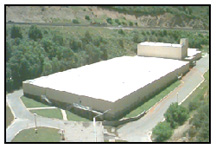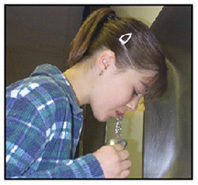National Drinking Water Week
April 27, 1999
|
According to AWWA, America’s suppliers’ process 34 billion gallons per day of drinking water supply. Six to eight glasses of water a day are needed each day for human good health. Moreover, this processed water is used (on command) for domestic household purposes. Salt Lake City processes an average of 80 million gallons per day of drinking water from 5 water treatment plants, deep wells and several springs to serve its 90,000 customer connections.
Safe drinking water is universally recognized as the foundation of every community, from the smallest hamlet to the largest city. Without it, good health, economic and social prosperity are not possible. Enormous expenditures have been made to protect, treat and deliver safe drinking water to America’s population. In recent years water utilities have invested billions of dollars in the development of advanced water treatment technologies.
This year’s cerebration is accentuated by the 25th anniversary of the Safe Drinking Water Act (“SDWA”) that will be commemorated on December 16, 1999. This federal law sets health and safety standards for public drinking water in the United States. Passed by Congress in 1974, this law established comprehensive national drinking water regulations and standards. The law was strengthen in 1986 and again in 1996. Under the current law, every public water system must test for more than 100 individual contaminants. Under the 1996 amendments, in 1999 each water purveyor is required to prepare a “Consumer Confidence Report” to be distributed to all customers within each water service area. Salt Lake City is currently preparing the report in accordance with prescribed requirements and it will be made available during the summer of 1999.
Salt Lake City is committed to providing quality water to its customers. The following action items have been undertaken to provide achieve meet that objective:
- In the mid-1950s, Salt Lake City began building water treatment plants to treat the public drinking water supply. A special 4-mil tax levy was imposed to finance water treatment and filtration plants and to cover distribution reservoirs. Since 1966, all of the city’s surface water supply has been fully treated and filtered in modern conventional water treatment plants. This was all accomplished before the passage of the SDWA.
- The city has implemented watershed protection programs to protect its raw water supply. For nearly a century the city has had watershed protection programs to protect its drinking water supply. In 1988, the City Council adopted a Canyon Watershed Management Plan; a 1999 update of this plan is currently before the City Council for action. In 1998, the City Council adopted a countywide “Ground Water Protection” ordinance. These are the primary programs to protect the city's drinking water sources of supply.
- The city joined with its other water suppliers in the EPA Partnership for Safe Drinking Water ("Partnership"). In 1995 the state’s five largest water organizations joined together to build a strong technical pool of individuals to optimize all the surface water treatment plant processes within their combined jurisdictions. Started as the Big Q group, (the Q was for Quality) it grew into the Utah Water Quality Alliance. The Alliance on February 12, 1997 inked their voluntary commitment with EPA in the Partnership four-phased program. The program begins with a survey of treatment facilities, treatment processes, operating and maintenance procedures and management oversight practices. The objective is to identify and prioritize areas that will enhance each treatment facility’s capability to prevent the entry of Crptosporidium and Giardia and other microbial contaminants into the treated water, and to voluntarily implement corrective actions that are appropriate for the system. Extensive data is collected, peer review teams evaluate and report their findings and finally a third party assessment is made. Water treatment plants providing water to Salt Lake City’s service area have met the requirements of phase 3, and are now ready for the final phase of the program.
- Imposed more stringent water quality standards than required by the SDWA. After the 1993 Milwaukee Cryptosporidium episode, Salt Lake City adopted a voluntary 0.1 NTU standard on its filtered drinking water. The SDWA standard was 0.5 NTU; this was changed to 0.3 NTU in 1998.
- Renovated and improved water treatment facilities, distribution reservoirs and distribution mains. In 1997, the City Council approved a multi-year $45.5 million capital improvement program to replace and upgrade water utility infrastructure. City officials are committed to meeting regulatory obligations and properly financing its drinking water programs.
- There has been enormous improvement in the quality of drinking water and the delivery of service over the past years. This has not been wi
thout great expense. Millions of dollars have been spent to operate and maintain the city’s water system and additional millions to fund capital improvements to upgrade the infrastructure. Additional millions will be necessary to continue this high level of quality and service.
Parleys Water Treatment Plant.
As we commemorate the anniversary of the Safe Drinking Water Act and celebrate AWWA’s National Drinking Water Week, we recognize and appreciate both our customers, and public officials who support our efforts to provide Safe Drinking Water.
Questions regarding this article can be directed to: leroy.hooton@ci.slc.ut.us
